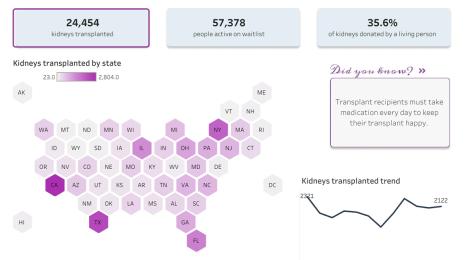Tracking gender equality with data: the 2022 SDG Gender Index
For a girl who is 10 years old today, how old will she be when her country achieves the Gender Equality targets in the UN’s 2030 Sustainable Development Goals (SDG)?
With 2030 just eight years away, the easy answer is 18 years old. But as Equal Measures 2030 (EM2030)’s 2022 SDG Gender Index shows, depending on the issue and the country she’s from, she could be anywhere between 20 and 70 before her country achieves gender equality—if it happens at all in her lifetime.
Measuring progress
Data is essential to the SDG movement. Measuring progress on goals related to Gender Equality has been difficult due to the lack of sex-disaggregated data available (often referred to as the ‘gender data gap’).That’s why EM2030 developed the SDG Gender Index. The Index surfaces data that measures overall progress towards gender equality for women and girls—just like that 10-year-old girl, wherever she may live.
A longtime Tableau Foundation partner, EM2030’s 2022 SDG Gender Index sheds fresh light on the work of governments and civil society organizations toward understanding issues of gender inequality, driving decision-making for positive change, and achieving gender equality by 2030.
The headline findings show progress, but clearly there is more work to be done. As of 2020, the Index highlights that more than three billion girls and women continue to live in countries with ‘poor’ or ‘very poor’ scores. Moreover, it shows that no country has achieved gender equality, and there is no best performer or top ten performers across all goals.
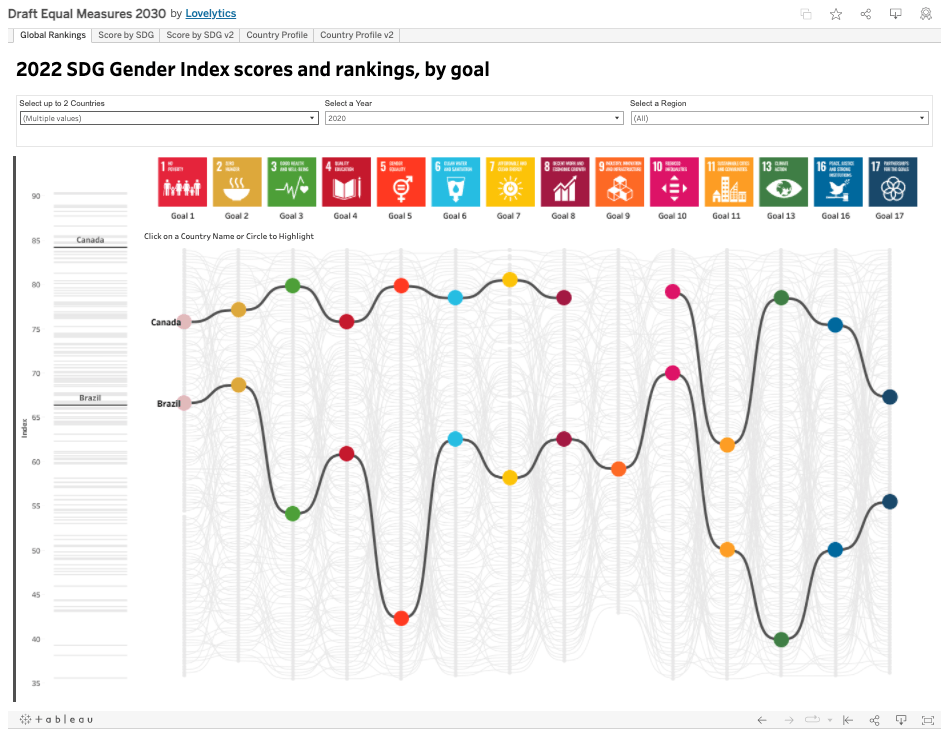
The 2022 SDG Gender Index covers 56 key indicators across 14 of the 17 SDGs, adding a gender lens across each of the goals. It captures data from 144 countries, and tracks progress over time for 135 of those countries between 2015 and 2020. Covering 98% of the world’s population of girls and women, the Index “aims to drive action on gender equality such that momentum towards equality becomes resilient, sustainable and, ultimately, unstoppable.”
So how are we doing?
While some progress is being made, the 2022 SDG Gender Index found that progress at a global level has been “too slow, too fragile and too fragmented” between 2015 and 2020. If this glacial pace continues, the 2030 deadline to achieve gender equality will not be met—the world will reach an Index score of only 71 out of 100 by 2030.
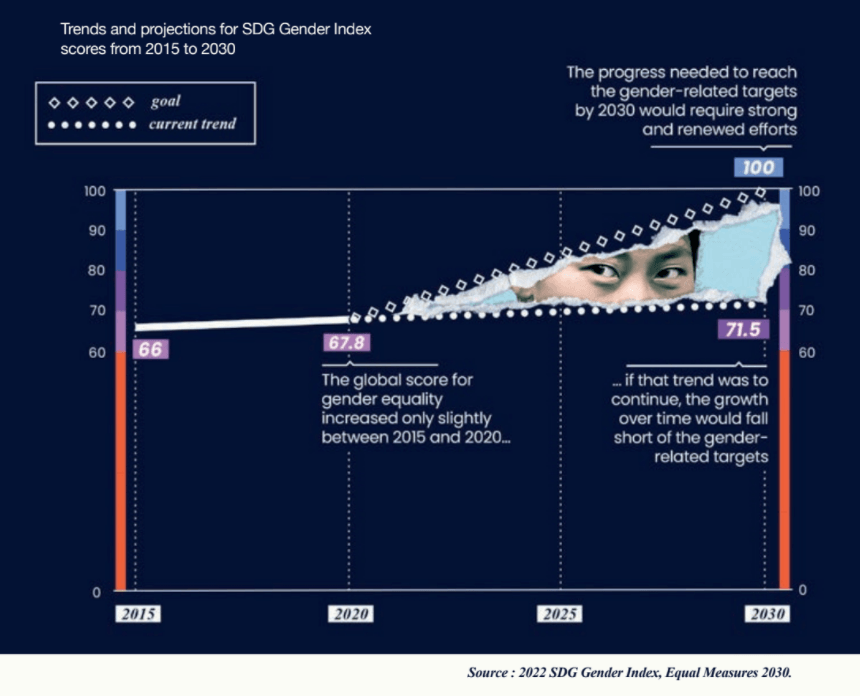
The majority of countries are moving in the right direction on some issues such as women’s use of digital banking, women in parliament, and view on state legitimacy and openness. For example, the report shows the second biggest increase between 2015 and 2020 globally, with ‘fast progress,’ covering indicators like women’s political participation. Although there is considerable improvement, the average score is still ‘poor’, demonstrating further investment is needed.
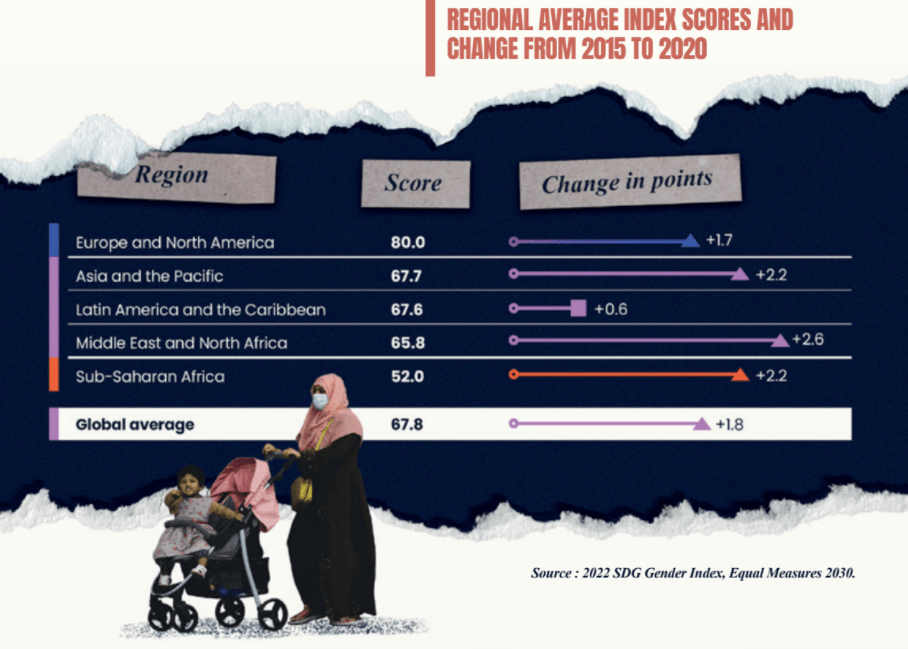
However, on other issues–carbon dioxide emissions, climate vulnerability, and anemia amongst non-pregnant women–a large proportion of countries are in the ‘no progress’ or moving in the ‘wrong direction’ camps.
“The Index can serve as a tool or a ‘warning light’ to draw attention to problematic areas. It can also help to identify ‘bright spots’ and pockets of progress,” said Alison Holder, director of Equal Measures 2030 in the report. “This nuanced picture can prompt deeper analysis and more probing questions about the underlying issues and what is driving progress, stagnation or decline in a country or worldwide.”
COVID-19 shocks gender equality efforts
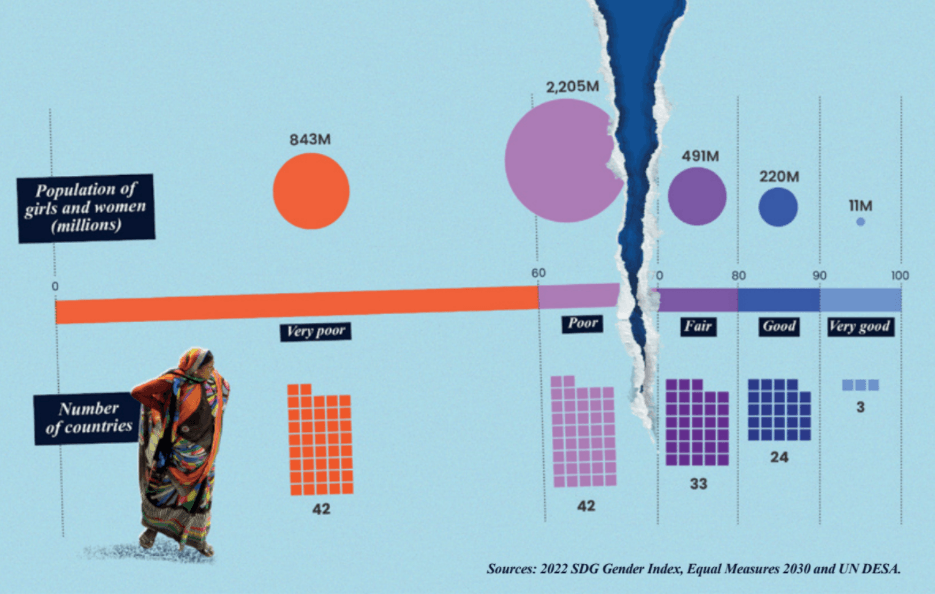
Around the world, data is showing that the COVID-19 pandemic has had a profound impact on the lives and welfare of women and girls. The Index shows that the COVID-19 pandemic intensified gender inequality, flagging issues like access to sexual and reproductive health services, women’s loss of employment, percentage of adolescent girls not returning to school, additional child marriages by 2030, and the increase of gender-based violence across countries.
The report explains that ‘getting back to normal’ is not enough, as the ‘normal’ that prevailed COVID-19 was not delivering progress at the scale, pace and intensity needed for sustainable gender equality. This severe impact is rooted in structural gaps and gender fault lines that existed long before the pandemic.
How do we move forward
The SDG Gender Index highlights that an intersectional lens is critical to understanding how inequalities combine and accumulate, and more so to identify problems and propose solutions.
The need for disaggregated and well-used data and evidence is key for empowerment and equality. This has become more palpable and advocacy efforts continue to be bolstered to address systematic inequalities and data gaps.
The analysis emphasizes that progress is possible “by setting out a blueprint for change that can ease the long-term impact of the COVID-19 pandemic on girls and women and build resilience to better weather future global shocks.”
Although EM2030 recognizes that drawing definitive policy recommendations that apply across 144 countries is impossible, the Index outlines a blueprint for change based on six cross-cutting themes that often appear in countries and regions making some progress towards the socio-economic development of girls and women worldwide:
- Reforming and applying inequality laws
- Investing in public services and social infrastructure
- Promoting the leadership, participation, and voice of girls and women
- Closing gender data gaps
- Investing in, creating space for, and listening to feminist organizations and movements
- Working with and empowering girls and young women
These six recommendations provide guidance needed for countries to implement the necessary policies to revitalize the long-term quest for sustainable gender equality and ensure they make the rapid progress needed to achieve the key targets by 2030.
The data alone cannot drive change. Tableau Foundation and EM2030 recognize the importance of local voices that bring the issues to life and can root discussions of change in data and facts. That's why Tableau Foundation is also supporting the Data Journalism Fellow Program in India and Kenya. The goal is to select data journalists who identify as women for a Tableau training program on a topic related to gender equality and empower them to build data-driven, impactful advocacy messages.
“If we are to reach the vision laid out in the Sustainable Development Goals for people and our planet, we must track progress - or the lack of it - with a gender lens across the whole of the 2030 Agenda. And we must use the resulting data to drive accountability for gender equality commitments” said Alison Holder, Director of Equal Measures 2030.




